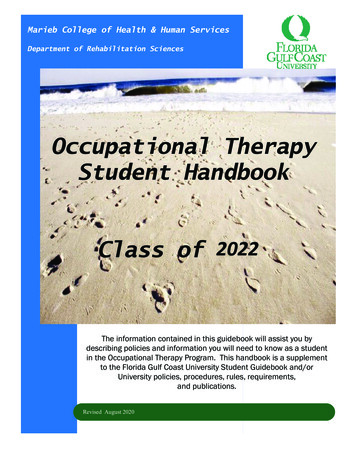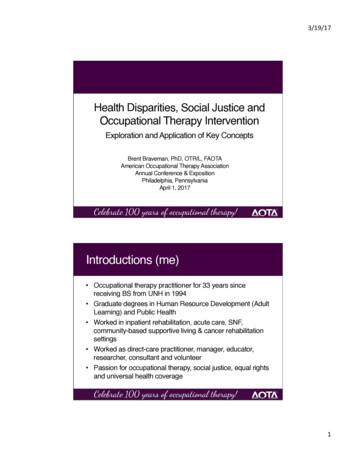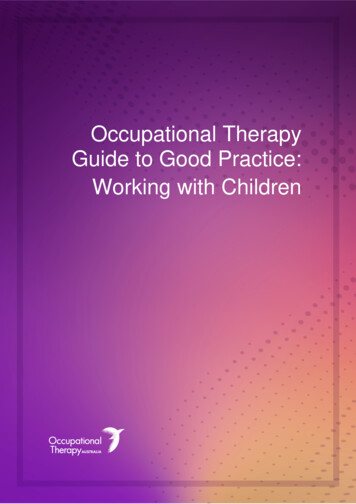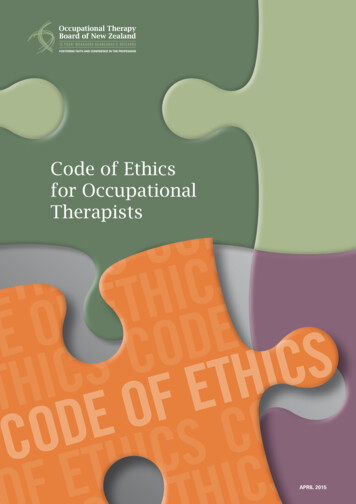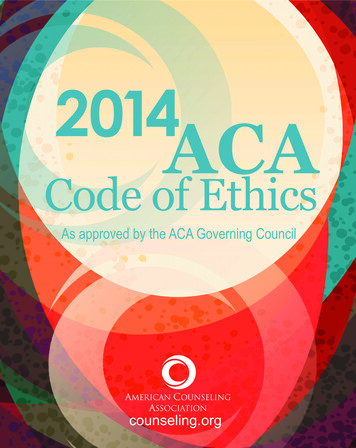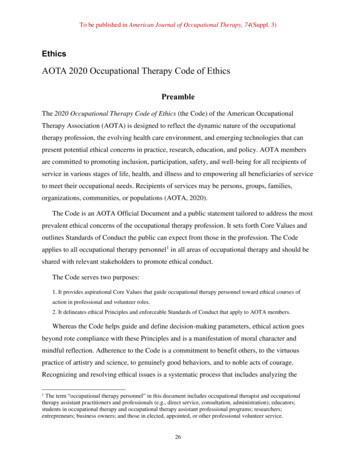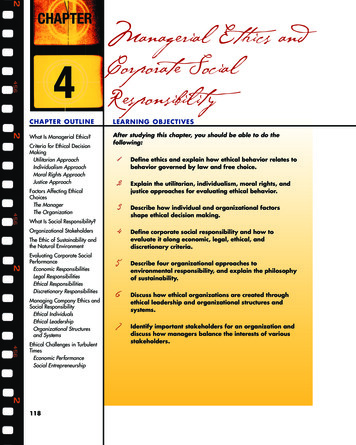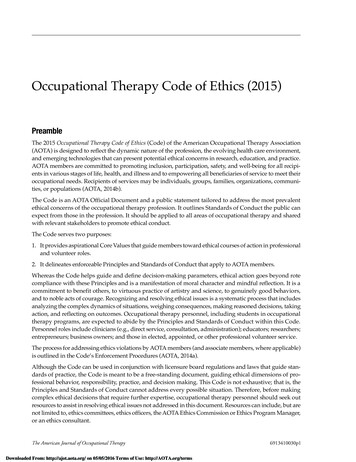
Transcription
Occupational Therapy Code of Ethics (2015)PreambleThe 2015 Occupational Therapy Code of Ethics (Code) of the American Occupational Therapy Association(AOTA) is designed to reflect the dynamic nature of the profession, the evolving health care environment,and emerging technologies that can present potential ethical concerns in research, education, and practice.AOTA members are committed to promoting inclusion, participation, safety, and well-being for all recipients in various stages of life, health, and illness and to empowering all beneficiaries of service to meet theiroccupational needs. Recipients of services may be individuals, groups, families, organizations, communities, or populations (AOTA, 2014b).The Code is an AOTA Official Document and a public statement tailored to address the most prevalentethical concerns of the occupational therapy profession. It outlines Standards of Conduct the public canexpect from those in the profession. It should be applied to all areas of occupational therapy and sharedwith relevant stakeholders to promote ethical conduct.The Code serves two purposes:1. It provides aspirational Core Values that guide members toward ethical courses of action in professionaland volunteer roles.2. It delineates enforceable Principles and Standards of Conduct that apply to AOTA members.Whereas the Code helps guide and define decision-making parameters, ethical action goes beyond rotecompliance with these Principles and is a manifestation of moral character and mindful reflection. It is acommitment to benefit others, to virtuous practice of artistry and science, to genuinely good behaviors,and to noble acts of courage. Recognizing and resolving ethical issues is a systematic process that includesanalyzing the complex dynamics of situations, weighing consequences, making reasoned decisions, takingaction, and reflecting on outcomes. Occupational therapy personnel, including students in occupationaltherapy programs, are expected to abide by the Principles and Standards of Conduct within this Code.Personnel roles include clinicians (e.g., direct service, consultation, administration); educators; researchers;entrepreneurs; business owners; and those in elected, appointed, or other professional volunteer service.The process for addressing ethics violations by AOTA members (and associate members, where applicable)is outlined in the Code’s Enforcement Procedures (AOTA, 2014a).Although the Code can be used in conjunction with licensure board regulations and laws that guide standards of practice, the Code is meant to be a free-standing document, guiding ethical dimensions of professional behavior, responsibility, practice, and decision making. This Code is not exhaustive; that is, thePrinciples and Standards of Conduct cannot address every possible situation. Therefore, before makingcomplex ethical decisions that require further expertise, occupational therapy personnel should seek outresources to assist in resolving ethical issues not addressed in this document. Resources can include, but arenot limited to, ethics committees, ethics officers, the AOTA Ethics Commission or Ethics Program Manager,or an ethics consultant.The American Journal of Occupational TherapyDownloaded From: http://ajot.aota.org/ on 05/05/2016 Terms of Use: http://AOTA.org/terms6913410030p1
Core ValuesThe profession is grounded in seven long-standing Core Values: (1) Altruism, (2) Equality, (3) Freedom, (4)Justice, (5) Dignity, (6) Truth, and (7) Prudence. Altruism involves demonstrating concern for the welfareof others. Equality refers to treating all people impartially and free of bias. Freedom and personal choiceare paramount in a profession in which the values and desires of the client guide our interventions. Justice expresses a state in which diverse communities are inclusive; diverse communities are organized andstructured such that all members can function, flourish, and live a satisfactory life. Occupational therapypersonnel, by virtue of the specific nature of the practice of occupational therapy, have a vested interest inaddressing unjust inequities that limit opportunities for participation in society (Braveman & Bass-Haugen, 2009).Inherent in the practice of occupational therapy is the promotion and preservation of the individuality andDignity of the client by treating him or her with respect in all interactions. In all situations, occupationaltherapy personnel must provide accurate information in oral, written, and electronic forms (Truth). Occupational therapy personnel use their clinical and ethical reasoning skills, sound judgment, and reflection tomake decisions in professional and volunteer roles (Prudence).The seven Core Values provide a foundation to guide occupational therapy personnel in their interactionswith others. Although the Core Values are not themselves enforceable standards, they should be considered when determining the most ethical course of action.Principles and Standards of ConductThe Principles and Standards of Conduct that are enforceable for professional behavior include (1)%HQHÀFHQFH 1RQPDOHÀFHQFH XWRQRP\ -XVWLFH 9HUDFLW\ DQG )LGHOLW\ 5HÁHFWLRQ RQ WKH historical foundations of occupational therapy and related professions resulted in the inclusion of Principlesthat are consistently referenced as a guideline for ethical decision making.BENEFICENCEPrinciple 1. Occupational therapy personnel shall demonstrate a concern for the well-being and safetyof the recipients of their services.Beneficence includes all forms of action intended to benefit other persons. The term beneficence connotesacts of mercy, kindness, and charity (Beauchamp & Childress, 2013). Beneficence requires taking action byhelping others, in other words, by promoting good, by preventing harm, and by removing harm. Examplesof beneficence include protecting and defending the rights of others, preventing harm from occurring toothers, removing conditions that will cause harm to others, helping persons with disabilities, and rescuingpersons in danger (Beauchamp & Childress, 2013).RELATED STANDARDS OF CONDUCTOccupational therapy personnel shallA.Provide appropriate evaluation and a plan of intervention for recipients of occupational therapyservices specific to their needs.B.Reevaluate and reassess recipients of service in a timely manner to determine whether goals arebeing achieved and whether intervention plans should be revised.C.Use, to the extent possible, evaluation, planning, intervention techniques, assessments, and therapeutic equipment that are evidence based, current, and within the recognized scope of occupationaltherapy practice.6913410030p2Downloaded From: http://ajot.aota.org/ on 05/05/2016 Terms of Use: http://AOTA.org/termsNovember/December 2015, Volume 69(Supplement 3)
D.Ensure that all duties delegated to other occupational therapy personnel are congruent with credentials, qualifications, experience, competency, and scope of practice with respect to service delivery,supervision, fieldwork education, and research.E.Provide occupational therapy services, including education and training, that are within each practitioner’s level of competence and scope of practice.F.Take steps (e.g., continuing education, research, supervision, training) to ensure proficiency, usecareful judgment, and weigh potential for harm when generally recognized standards do not existin emerging technology or areas of practice.G.Maintain competency by ongoing participation in education relevant to one’s practice area.H.Terminate occupational therapy services in collaboration with the service recipient or responsibleparty when the services are no longer beneficial.I.Refer to other providers when indicated by the needs of the client.J.Conduct and disseminate research in accordance with currently accepted ethical guidelines andstandards for the protection of research participants, including determination of potential risks andbenefits.NONMALEFICENCEPrinciple 2. Occupational therapy personnel shall refrain from actions that cause harm.Nonmaleficence “obligates us to abstain from causing harm to others” (Beauchamp & Childress, 2013, p.150). The Principle of Nonmaleficence also includes an obligation to not impose risks of harm even if thepotential risk is without malicious or harmful intent. This Principle often is examined under the context ofdue care. The standard of due care “requires that the goals pursued justify the risks that must be imposed toachieve those goals” (Beauchamp & Childress, 2013, p. 154). For example, in occupational therapy practice,this standard applies to situations in which the client might feel pain from a treatment intervention; however, the acute pain is justified by potential longitudinal, evidence-based benefits of the treatment.RELATED STANDARDS OF CONDUCTOccupational therapy personnel shallA.Avoid inflicting harm or injury to recipients of occupational therapy services, students, researchparticipants, or employees.B.Avoid abandoning the service recipient by facilitating appropriate transitions when unable to provide services for any reason.C.Recognize and take appropriate action to remedy personal problems and limitations that mightcause harm to recipients of service, colleagues, students, research participants, or others.D.Avoid any undue influences that may impair practice and compromise the ability to safely andcompetently provide occupational therapy services, education, or research.E.Address impaired practice and , when necessary, report it to the appropriate authorities.F.Avoid dual relationships, conflicts of interest, and situations in which a practitioner, educator, student, researcher, or employer is unable to maintain clear professional boundaries or objectivity.G.Avoid engaging in sexual activity with a recipient of service, including the client’s family or significant other, student, research participant, or employee, while a professional relationship exists.The American Journal of Occupational TherapyDownloaded From: http://ajot.aota.org/ on 05/05/2016 Terms of Use: http://AOTA.org/terms6913410030p3
H.Avoid compromising the rights or well-being of others based on arbitrary directives (e.g., unrealisticproductivity expectations, falsification of documentation, inaccurate coding) by exercising professional judgment and critical analysis.I.Avoid exploiting any relationship established as an occupational therapy clinician, educator, orresearcher to further one’s own physical, emotional, financial, political, or business interests at theexpense of recipients of services, students, research participants, employees, or colleagues.J.Avoid bartering for services when there is the potential for exploitation and conflict of interest.AUTONOMYPrinciple 3. Occupational therapy personnel shall respect the right of the individual to self-determination, privacy, confidentiality, and consent.The Principle of Autonomy expresses the concept that practitioners have a duty to treat the client accordingto the client’s desires, within the bounds of accepted standards of care, and to protect the client’s confidential information. Often, respect for Autonomy is referred to as the self-determination principle. However, respecting a person’s autonomy goes beyond acknowledging an individual as a mere agent and alsoacknowledges a person’s right “to hold views, to make choices, and to take actions based on [his or her]values and beliefs” (Beauchamp & Childress, 2013, p. 106). Individuals have the right to make a determination regarding care decisions that directly affect their lives. In the event that a person lacks decision-makingcapacity, his or her autonomy should be respected through involvement of an authorized agent or surrogate decision maker.RELATED STANDARDS OF CONDUCTOccupational therapy personnel shallA.Respect and honor the expressed wishes of recipients of service.B.Fully disclose the benefits, risks, and potential outcomes of any intervention; the personnel who willbe providing the intervention; and any reasonable alternatives to the proposed intervention.C.Obtain consent after disclosing appropriate information and answering any questions posed by therecipient of service or research participant to ensure voluntariness.D.Establish a collaborative relationship with recipients of service and relevant stakeholders to promote shared decision making.E.Respect the client’s right to refuse occupational therapy services temporarily or permanently, evenwhen that refusal has potential to result in poor outcomes.F.Refrain from threatening, coercing, or deceiving clients to promote compliance with occupationaltherapy recommendations.G.Respect a research participant’s right to withdraw from a research study without penalty.H.Maintain the confidentiality of all verbal, written, electronic, augmentative, and nonverbal communications, in compliance with applicable laws, including all aspects of privacy laws and exceptionsthereto (e.g., Health Insurance Portability and Accountability Act [Pub. L. 104–191], Family Educational Rights and Privacy Act [Pub. L. 93–380]).I.Display responsible conduct and discretion when engaging in social networking, including but notlimited to refraining from posting protected health information.6913410030p4Downloaded From: http://ajot.aota.org/ on 05/05/2016 Terms of Use: http://AOTA.org/termsNovember/December 2015, Volume 69(Supplement 3)
J.Facilitate comprehension and address barriers to communication (e.g., aphasia; differences in language, literacy, culture) with the recipient of service (or responsible party), student, or researchparticipant.JUSTICEPrinciple 4. Occupational therapy personnel shall promote fairness and objectivity in the provision ofoccupational therapy services.The Principle of Justice relates to the fair, equitable, and appropriate treatment of persons (Beauchamp &Childress, 2013). Occupational therapy personnel should relate in a respectful, fair, and impartial mannerto individuals and groups with whom they interact. They should also respect the applicable laws and standards related to their area of practice. Justice requires the impartial consideration and consistent followingof rules to generate unbiased decisions and promote fairness. As occupational therapy personnel, we workto uphold a society in which all individuals have an equitable opportunity to achieve occupational engagement as an essential component of their life.RELATED STANDARDS OF CONDUCTOccupational therapy personnel shallA.Respond to requests for occupational therapy services (e.g., a referral) in a timely manner as determined by law, regulation, or policy.B.Assist those in need of occupational therapy services in securing access through available means.C.Address barriers in access to occupational therapy services by offering or referring clients to financial aid, charity care, or pro bono services within the parameters of organizational policies.D.Advocate for changes to systems and policies that are discriminatory or unfairly limit or preventaccess to occupational therapy services.E.Maintain awareness of current laws and AOTA policies and Official Documents that apply to theprofession of occupational therapy.F.Inform employers, employees, colleagues, students, and researchers of applicable policies, laws,and Official Documents.G.Hold requisite credentials for the occupational therapy services they provide in academic, research,physical, or virtual work settings.H.Provide appropriate supervision in accordance with AOTA Official Documents and relevant laws,regulations, policies, procedures, standards, and guidelines.I.Obtain all necessary approvals prior to initiating research activities.J.Refrain from accepting gifts that would unduly influence the therapeutic relationship or have thepotential to blur professional boundaries, and adhere to employer policies when offered gifts.K.Report to appropriate authorities any acts in practice, education, and research that are unethical orillegal.L.Collaborate with employers to formulate policies and procedures in compliance with legal, regulatory, and ethical standards and work to resolve any conflicts or inconsistencies.M. Bill and collect fees legally and justly in a manner that is fair, reasonable, and commensurate withservices delivered.The American Journal of Occupational TherapyDownloaded From: http://ajot.aota.org/ on 05/05/2016 Terms of Use: http://AOTA.org/terms6913410030p5
N.Ensure compliance with relevant laws, and promote transparency when participating in a businessarrangement as owner, stockholder, partner, or employee.O.Ensure that documentation for reimbursement purposes is done in accordance with applicablelaws, guidelines, and regulations.P.Refrain from participating in any action resulting in unauthorized access to educational content orexams (including but not limited to sharing test questions, unauthorized use of or access to contentor codes, or selling access or authorization codes).VERACITYPrinciple 5. Occupational therapy personnel shall provide comprehensive, accurate, and objective information when representing the profession.Veracity is based on the virtues of truthfulness, candor, and honesty. The Principle of Veracity refers tocomprehensive, accurate, and objective transmission of information and includes fostering understandingof such information (Beauchamp & Childress, 2013). Veracity is based on respect owed to others, includingbut not limited to recipients of service, colleagues, students, researchers, and research participants.In communicating with others, occupational therapy personnel implicitly promise to be truthful and notdeceptive. When entering into a therapeutic or research relationship, the recipient of service or researchparticipant has a right to accurate information. In addition, transmission of information is incomplete without also ensuring that the recipient or participant understands the information provided.Concepts of veracity must be carefully balanced with other potentially competing ethical principles,cultural beliefs, and organizational policies. Veracity ultimately is valued as a means to establish trustand strengthen professional relationships. Therefore, adherence to the Principle of Veracity also requiresthoughtful analysis of how full disclosure of information may affect outcomes.RELATED STANDARDS OF CONDUCTOccupational therapy personnel shallA.Represent credentials, qualifications, education, experience, training, roles, duties, competence,contributions, and findings accurately in all forms of communication.B.Refrain from using or participating in the use of any form of communication that contains false,fraudulent, deceptive, misleading, or unfair statements or claims.C.Record and report in an accurate and timely manner and in accordance with applicable regulationsall information related to professional or academic documentation and activities.D.Identify and fully disclose to all appropriate persons errors or adverse events that compromise thesafety of service recipients.E.Ensure that all marketing and advertising are truthful, accurate, and carefully presented to avoidmisleading recipients of service, research participants, or the public.F.Describe the type and duration of occupational therapy services accurately in professional contracts, including the duties and responsibilities of all involved parties.G.Be honest, fair, accurate, respectful, and timely in gathering and reporting fact-based informationregarding employee job performance and student performance.H.Give credit and recognition when using the ideas and work of others in written, oral, or electronicmedia (i.e., do not plagiarize).6913410030p6Downloaded From: http://ajot.aota.org/ on 05/05/2016 Terms of Use: http://AOTA.org/termsNovember/December 2015, Volume 69(Supplement 3)
I.Provide students with access to accurate information regarding educational requirements and academic policies and procedures relative to the occupational therapy program or educational institution.J.Maintain privacy and truthfulness when using telecommunication in the delivery of occupationaltherapy services.FIDELITYPrinciple 6. Occupational therapy personnel shall treat clients, colleagues, and other professionals withrespect, fairness, discretion, and integrity.The Principle of Fidelity comes from the Latin root fidelis, meaning loyal. Fidelity refers to the duty one hasto keep a commitment once it is made (Veatch, Haddad, & English, 2010). In the health professions, thiscommitment refers to promises made between a provider and a client or patient based on an expectationof loyalty, staying with the client or patient in a time of need, and compliance with a code of ethics. Thesepromises can be implied or explicit. The duty to disclose information that is potentially meaningful in makingdecisions is one obligation of the moral contract between provider and client or patient (Veatch et al., 2010).Whereas respecting Fidelity requires occupational therapy personnel to meet the client’s reasonable expectations, the Principle also addresses maintaining respectful collegial and organizational relationships(Purtilo & Doherty, 2011). Professional relationships are greatly influenced by the complexity of the environment in which occupational therapy personnel work. Practitioners, educators, and researchers alikemust consistently balance their duties to service recipients, students, research participants, and other professionals as well as to organizations that may influence decision making and professional practice.RELATED STANDARDS OF CONDUCTOccupational therapy personnel shallA.Preserve, respect, and safeguard private information about employees, colleagues, and studentsunless otherwise mandated or permitted by relevant laws.B.Address incompetent, disruptive, unethical, illegal, or impaired practice that jeopardizes the safetyor well-being of others and team effectiveness.C.Avoid conflicts of interest or conflicts of commitment in employment, volunteer roles, or research.D.Avoid using one’s position (employee or volunteer) or knowledge gained from that position in sucha manner as to give rise to real or perceived conflict of interest among the person, the employer,other AOTA members, or other organizations.E.Be diligent stewards of human, financial, and material resources of their employers, and refrainfrom exploiting these resources for personal gain.F.Refrain from verbal, physical, emotional, or sexual harassment of peers or colleagues.G.Refrain from communication that is derogatory, intimidating, or disrespectful and that unduly discourages others from participating in professional dialogue.H.Promote collaborative actions and communication as a member of interprofessional teams to facilitate quality care and safety for clients.I.Respect the practices, competencies, roles, and responsibilities of their own and other professions topromote a collaborative environment reflective of interprofessional teams.J.Use conflict resolution and internal and alternative dispute resolution resources as needed to resolveorganizational and interpersonal conflicts, as well as perceived institutional ethics violations.The American Journal of Occupational TherapyDownloaded From: http://ajot.aota.org/ on 05/05/2016 Terms of Use: http://AOTA.org/terms6913410030p7
K.Abide by policies, procedures, and protocols when serving or acting on behalf of a professionalorganization or employer to fully and accurately represent the organization’s official and authorized positions.L.Refrain from actions that reduce the public’s trust in occupational therapy.M. Self-identify when personal, cultural, or religious values preclude, or are anticipated to negatively affect,the professional relationship or provision of services, while adhering to organizational policies whenrequesting an exemption from service to an individual or group on the basis of conflict of conscience.ReferencesAmerican Occupational Therapy Association. (2014a). Enforcement procedures for the Occupationaltherapy code of ethics and ethics standards. American Journal of Occupational Therapy, 68(Suppl. 3), 2American Occupational Therapy Association. (2014b). Occupational therapy practice framework:Domain and process (3rd ed.). American Journal of Occupational Therapy, 68(Suppl. 1), S1–S48. p, T. L., & Childress, J. F. (2013). Principles of biomedical ethics (7th ed.). New York: OxfordUniversity Press.Braveman, B., & Bass-Haugen, J. D. (2009). Social justice and health disparities: An evolving discoursein occupational therapy research and intervention. American Journal of Occupational Therapy, 63, o, R., & Doherty, R. (2011). Ethical dimensions in the health professions (5th ed.). Philadelphia:Saunders/Elsevier.Veatch, R. M., Haddad, A. M., & English, D. C. (2010). Case studies in biomedical ethics. New York: OxfordUniversity Press.Ethics CommissionYvette Hachtel, JD, OTR/L, Chair (2013–2014)Lea Cheyney Brandt, OTD, MA, OTR/L, Chair (2014–2015)Ann Moodey Ashe, MHS, OTR/L (2011–2014)Joanne Estes, PhD, OTR/L (2012–2015)Loretta Jean Foster, MS, COTA/L (2011–2014)Wayne L. Winistorfer, MPA, OTR (2014–2017)Linda Scheirton, PhD, RDH (2012–2015)Kate Payne, JD, RN (2013–2014)Margaret R. Moon, MD, MPH, FAAP (2014–2016)Kimberly S. Erler, MS, OTR/L (2014–2017)Kathleen McCracken, MHA, COTA/L (2014–2017)Deborah Yarett Slater, MS, OT/L, FAOTA, AOTA Ethics Program ManagerAdopted by the Representative Assembly 2015AprilC3.Note. This document replaces the 2010 document Occupational Therapy Code of Ethics and Ethics Standards (2010),previously published and copyrighted in 2010 by the American Occupational Therapy Association in the AmericanJournal of Occupational Therapy, 64, S17–S26. http://dx.doi.org/10.5014/ajot.2010.64S17Copyright 2015 by the American Occupational Therapy Association.Citation. American Occupational Therapy Association. (2015). Occupational therapy code of ethics (2015). AmericanJournal of Occupational Therapy, 69(Suppl. 3), 6913410030. 30p8Downloaded From: http://ajot.aota.org/ on 05/05/2016 Terms of Use: http://AOTA.org/termsNovember/December 2015, Volume 69(Supplement 3)
The Principle of Autonomy expresses the concept that practitioners have a duty to treat the client according to the client's desires, within the bounds of accepted standards of care, and to protect the client's confi-dential information. Often, respect for Autonomy is referred to as the self-determination principle. How-
